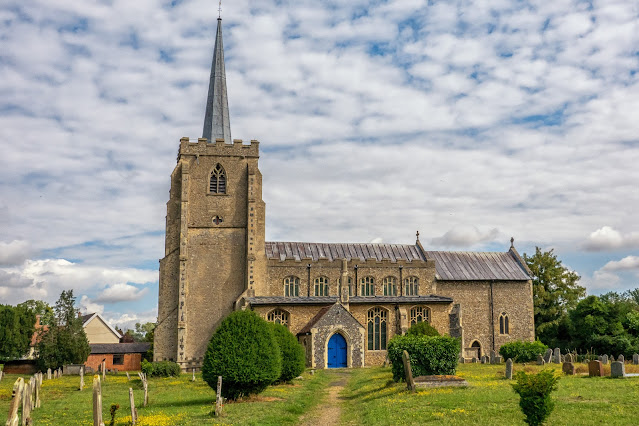Bramford - and the sad story of baby Innocent
As I had not seen this `local` church, this trip was just to explore. However, it turned out to have a sad twist to its story. I parked my car on the south side, near the vicarage, as it turned out. So firstly, some pictures of this south side of the building.
"Another Suffolk church that can probably be associated with the group identified by the late Birkin Haward as having been part-built by the same master mason, 'Hawes of Occold', fl. 1410-1440."
I have read that this church's style is Perpendicular Gothic. What are the characteristics of Perpendicular Gothic style - I wondered!
Apparently, the style was concerned with creating rich visual effects through decoration and was characterized by a predominance of vertical lines in stone window tracery, enlargement of the windows to great proportions. Hence the view of the windows above, which demonstrates the emphasis on vertical lines.
The late fourteenth century north porch may have been added at the same time as the figure and animal pinnacles were added to the nave and north aisle, (see images below) perhaps in 1468, when a bequest was left for work 'to the body of the church'. It seems virtually certain that before this porch was built, the principal entrance to the church had been from the south, for the north doorway (inside the porch) is modest and off-centre, and clearly not designed to be part of a grand entrance.
Along the battlements of the north aisles, statues on pinnacles stand like guardians. These are unusual in East Anglia. Some of them are allegorical, some theological, some perhaps mythical or heraldic. They are hard to photograph, or even to see clearly, on a sunny day because they are on the north side of the church, and in any case, they are eroded by half a millennium of soft Suffolk rain and encrusted with lichen. One is clearly an ape in a monk's habit examining a urine flask. This can also be seen on the screen at Suffield in Norfolk. It is a satire on contemplative orders. The ape here is chained, suggesting that he is tied to his friary. Two others are evangelistic symbols of St Matthew and St Mark. One of the strangest is a woodwose, the wild man of the Suffolk woods. He is commonly found in late medieval carvings and often he carries a club, but the one here also appears to be wearing a crown. There is a gryphon and a chained beast, and a curious animal that might be a hare or a sheep, though both are unusual in late medieval East Anglian stonework.
I managed to photograph the above two and in the previous photo you can make out several of them dotted along the battlement.
Remember ye pore
The Scripture doth record
What to them is geven
Is lent unto the Lord
1591
It would have been above a poor box, and indeed, it is still above a 20th Century box today.
The church's most impressive internal feature is the three-bay stone screen filling the space beneath the chancel arch. This is thirteenth century work but the two large, encircled quatrefoils piercing the spandrels and the castellated stone rail on the top are probably Victorian 'improvements', probably by the designer of the chancel arch above - Ewan Christian (1814-95),
The reredos by W D Caroe is a good example of turn-of-the-last-century seriousness. It sits beneath a familiarly stodgy window by Kempe & Co, typical of their early 20th Century style. The bulky choir stalls, also by Caroe, have been removed from the chancel and placed in the south aisle. The chancel must have felt very cramped when they were still in situ. I think that the current layout is very welcoming, and I was only too happy to tell a lady outside - only to find she was the Rectors wife!
A more recent, and I am afraid more traumatic, incident in Bramford's long history is remembered by a small grave marker along the path to the south of the church. Resting here, a baby boy, one of God's children, reads the inscription. The area of woodland east of the church beside the river is known locally as the Marshes. On Sunday 11th March 1984 some teenagers were sheltering from the rain in the Marshes under a tree. Bored, one of them kicked over an old car petrol tank which had been dumped. Underneath, they found the body of a baby boy. The pathologist's report revealed that the child had been about a week old and had not died of natural causes. The little boy was buried in Bramford churchyard. An exhaustive police investigation was unable to solve the mystery.













Comments